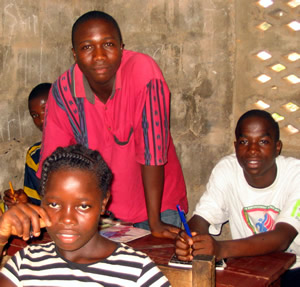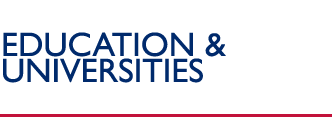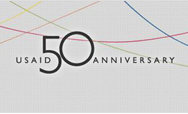Youth Development
There are 1.5 billion people between the ages of 12-24 worldwide. According to the World Development Report 2007, 1.3 billion young people live in developing countries, the most ever in history. Young people represent a disproportionately large part of the world’s poor. More importantly, youth are an enormous resource for national development. Decisions that they make about child-bearing, and opportunities they have for education, training, employment, and civic participation will affect their countries’ development outcomes for years to come.

Youth in Liberia, often ex-combatants from the 14-year civil war, make up for lost time learning literacy, life skills, and more through USAID’s Accelerated Learning Program Plus (ALPP).
(Credit – Yolande Miller-Grandvaux) |
|
In order to realize their potential, young people must successfully navigate the transition from childhood to productive adulthood. Societies—including governments, families, civil society organizations, and the private sector—play critical roles in enabling successful transition of young people by supporting their development in a holistic fashion. Investment in youth development takes many forms, including education, health, employment, civic engagement, and recreation, and needs to be coordinated to ensure all young people are supported. The engagement of youth as active contributors to development of their communities and nations is critical and involves providing opportunities for youth to develop their voice and be heard by their communities.
USAID supports youth programs that address a diverse spectrum of youth needs and draws on technical expertise in education, health, democracy and governance, natural resource management, economic development, and agriculture. Specific activities include:
- Literacy for Out-of-School Youth: USAID’s Basic Education and EQUIP 3 programs provide training in literacy, numeracy and other basic skills for out-of-school youth through initiatives such as Liberia’s Accelerated Learning Program.
- Youth & HIV/AIDS: Almost half of all new HIV infections in developing countries are among 15 to 24 year-olds. USAID is using media campaigns, peer counseling, life skills training, and interventions for youth in particularly vulnerable circumstances. These kinds of activities are designed to reach youth with prevention messages and help them develop the skills necessary to protect themselves.
- Youth Livelihoods: Livelihood development programming, such as USAID/Haiti’s IDEJEN project, aims to enhance the readiness of young people to engage in livelihoods activities, such as: (a) employment; (b) household-based activities; and (c) self-employment oriented micro-enterprise activities.
- Youth & Workforce Development: USAID’s Workforce Development programs focus on developing youth employability skills, such as critical thinking and facility with computer technology, as well as specific technical/vocational skills, in response to industry workforce demands through programs like USAID/East Timor’s JOB Opportunities Project.
- Youth & Microenterprise: USAID’s Microenterprise Development Office collaborates with field practitioners and programs to develop, implement, and assess the impact of market-oriented strategies that advance the economic situation of youth. The Youth Livelihoods program within the MicroLinks activity is an example of such programs.
- Youth & Post-Conflict Stability: USAID’s Conflict Management and Mitigation Office is helping USAID to engage young people often left behind by more traditional development programs. Programs such as USAID/Middle East’s Developing Leaders Program reintegrate former child soldiers, create opportunities for youth to participate in community and political arenas, and provide job training.
- Youth & Civic Participation: Enhancing youth civic participation is key to creating an environment supportive of civil society, especially in countries with fragile democratic traditions. (for example Serbia’s Summer Basketball Camps).
Back to Top ^ |




